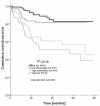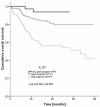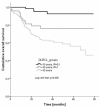The diffuse large B-cell lymphoma - where do we stand now in everyday clinical practice
- PMID: 23077452
- PMCID: PMC3472942
- DOI: 10.2478/v10019-012-0002-6
The diffuse large B-cell lymphoma - where do we stand now in everyday clinical practice
Abstract
Background: Due to superior results observed with the addition of rituximab into treatment of patients with the diffuse large B-cell lymphoma (DLBCL),the R-CHOP (rituximab, cyclophosphamide, doxorubicin, vincristine, and prednisolone) regimen and its variants became the standard initial treatment of these patients. However, the treatment recommendations are based on results of clinical studies while the conditions of routine treatment are far different from the ones in clinical studies. The aim of this retrospective study was therefore to compare the treatment results of routinely treated patients with the DLBCL to results reported by some larger studies.
Patients and methods: Two hundred and ninety five patients with the DLBCL were treated between 2004 and 2008 according to the then protocol with R-CHOP or R-CHOP-like regimens at the Institute of Oncology Ljubljana. Treatment response was evaluated according to Cheson's criteria and the disease-free and overall survival by means of Kaplan Meier survival curves.
Results: Response to treatment in our evaluation diverged from the reported one predominately in the low risk group (international prognostic index [IPI] categorisation) and in the very good prognosis group (revised international prognostic index (R-IPI) categorisation). The determined complete response (CR) rates in other IPI and R-IPI groups were generally within expectations. Also in the disease-free survival the largest discrepancy occurred in the low-risk patient group (3 year disease-free survival rate of 75%) and in the very good prognosis group (4 year disease-free survival rate of 59%). In all other IPI risk groups, the disease-free survival at 3 years (low intermediate risk 76%, high intermediate risk group 57%, and high risk group 53%) agreed very well with the quoted ones. Slightly worse was the compliance of the 4 year disease-free survival rates (72% in the good prognosis and 51% in the poor prognosis group) with the results from the literature. The 3 year overall survival rates (low risk patients 87%, high intermediate risk 61% and high risk patients 51%) were somewhat worse than the reported ones in all IPI subgroups except in the low intermediate risk group (82%). On the other hand, the 4 year overall survival rates of the R-IPI categories (94% in the very good prognosis group, 80% in the good prognosis group, 56% in the poor prognosis group) were much better correlated with the data from the literature.
Conclusions: In total, the treatment outcomes of routinely treated patient with the DLBCL at our institute are quite encouraging when compared to results of some larger studies. There are probably no dilemmas about how to treat young good prognosis patients and patients aged over 60 years at present. However, the 5 year overall survival rate of 76% for the young poor prognosis group is unsatisfying and needs to be improved. At present, quite a few studies are underway to clarify which of the regimens will perform best in this population.
Keywords: R-CHOP; diffuse large B-cell lymphoma; routine treatments; treatment result.
Figures







References
-
- Swerdlow SH, Campo E, Harris NL, Pileri SA, Stein H, Thiele J, et al., editors. WHO classification of tumours of haematopoietic and lymphoid tissues. 4th edition. Lyon, France: International Agency for Research on Cancer; 2008.
-
- Žakelj Primic M, Bračko M, Pompe-Kirn V, Zakotnik B, editors. Rak v Sloveniji 2007. Ljubljana: Onkološki inštitut Ljubljana, Epidemiologija in register raka, Register raka Republike Slovenije; 2010.
-
- Shipp M, Harrington D, Anderson J, Armitage JO, Bonadonna G, Brittinger G, et al. A predictive model for aggressive non-Hodgkin¢s lymphomas. N Engl J Med. 1993;329:987–94. - PubMed
LinkOut - more resources
Full Text Sources
Research Materials
